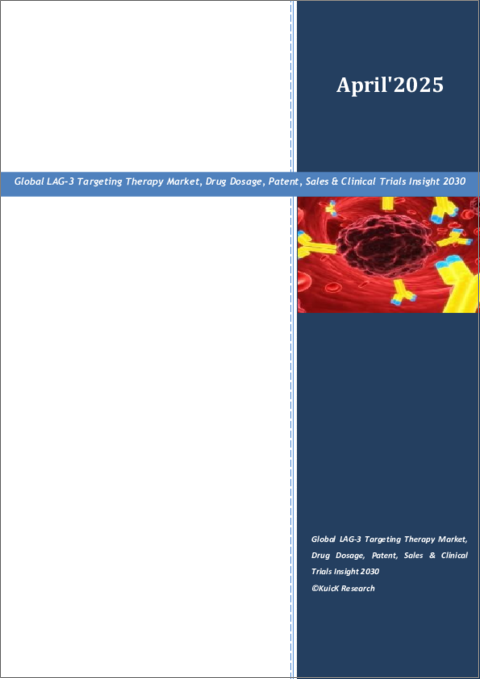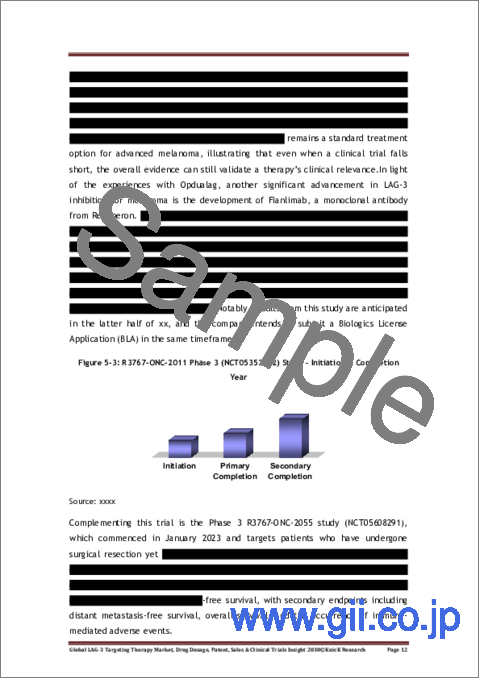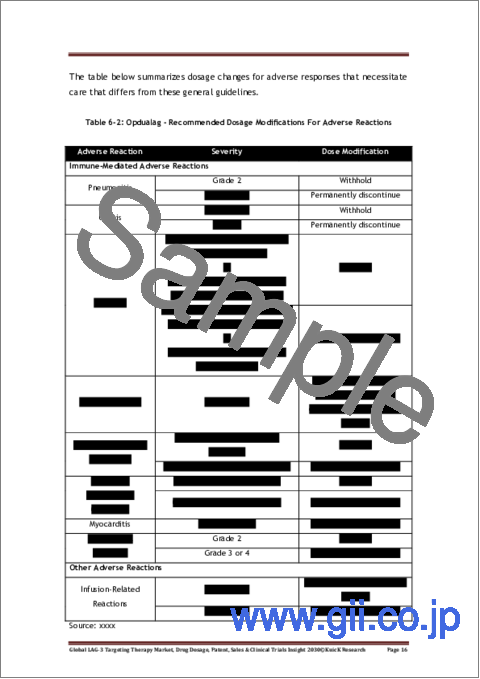|
|
市場調査レポート
商品コード
1695957
LAG-3標的療法の世界市場:用量、特許、売上、臨床試験に関する洞察(2030年)Global LAG-3 Targeting Therapy Market, Drug Dosage, Patent, Sales & Clinical Trials Insight 2030 |
||||||
|
|||||||
| LAG-3標的療法の世界市場:用量、特許、売上、臨床試験に関する洞察(2030年) |
|
出版日: 2025年04月01日
発行: KuicK Research
ページ情報: 英文 190 Pages
納期: 即日から翌営業日
|
全表示
- 概要
- 図表
- 目次
世界のLAG-3標的療法の市場規模は、2030年までに40億米ドル以上となる見込みです。
LAG-3標的療法は、がん、自己免疫疾患、炎症性疾患など多くの疾患の治療に応用できる可能性があり、世界市場の注目を集めています。リンパ球活性化遺伝子3(LAG-3)と呼ばれる免疫チェックポイント受容体は、免疫反応の制御に不可欠です。そのため、活性化、枯渇、阻害のいずれかの方法でLAG-3の活性を改変する治療法が数多く開発されており、それぞれにユニークな治療用途があります。その中で最もポピュラーな戦略はLAG-3阻害であるが、イミューテップ社が開発したLAG-3活性化および枯渇化もまたポピュラーになりつつあります。
この市場において、LAG-3阻害は、がん細胞を認識し排除する免疫系の能力を向上させることを目的としているため、依然として最も人気のある治療戦略です。このアプローチでは、主にモノクローナル抗体を使用します。モノクローナル抗体はLAG-3レセプターを阻害することを目的としており、腫瘍細胞を攻撃するT細胞を効果的に最大化します。TIGITとLAG-3の両方を標的とするZGGS-15のような二重特異性抗体は、今後の革新的な治療法です。Suzhou Zelgen BiopharmaceuticalsのZGGS-15は固形がんの治療に特化して設計されています。二重特異性抗体は、2つの免疫チェックポイント経路を同時に標的とすることで、免疫療法の効果を高める可能性があります。
がんに加えて、研究者たちはLAG-3標的が自己免疫疾患や炎症性疾患の治療にどのように使用されるかも調べています。この分野の調査はまだ初期段階であるが、LAG-3の調節が微生物疾患において治療効果があることを示唆する証拠も増えてきています。LAG-3阻害は腫瘍がもたらす免疫抑制を克服する手段と考えられています。
抗PD-1モノクローナル抗体ニボルマブと抗LAG-3モノクローナル抗体レラトリマブを組み合わせた薬剤オプデュアラグは、この分野における重要な成功例です。2022年に承認されたオプデュアラグの売上は同年2億5,000万米ドルを超え、2024年には9億米ドルを超えました。この目覚ましい拡大は、同様の治療法の将来が有望であることを示しており、腫瘍学市場においてLAG-3標的治療薬が受け入れられつつあることを反映しています。
現在、35を超えるLAG-3標的候補が臨床開発中であり、この領域における幅広い関心と絶え間ない技術革新が実証されています。Regeneron Pharmaceuticalsは、その主要候補の一つであるフィアンリマブにより、この市場における主要参入企業となっています。現在第3相試験中のフィアンリマブは、多くのがん適応症で評価されており、治療環境に大きな影響を与える可能性があります。ファースト・イン・クラスのLAG-3アゴニストであるイミューテップのIMP-761も、エキサイティングな候補です。IMP-761は、ヒトを対象とした初期段階の臨床試験で安全性と有効性が確認されつつあり、その後、自己免疫疾患にも治療が拡大される予定です。
このように、LAG-3標的治療薬の臨床試験数の増加と適応症の拡大は、この市場が今後数年で大きく成長することを示しています。モノクローナル抗体と二重特異性抗体の融合は、LAG-3アゴニズムと枯渇の継続的な追求とともに、がん、自己免疫疾患、そしてそれ以上の疾患の管理に革命をもたらす可能性のある幅広い治療法を提示しています。LAG-3標的療法は、研究が進むにつれて免疫腫瘍学やその他の免疫関連疾患においてますます不可欠なものとなり、市場のさらなる成長を促進すると予想されます。
当レポートは、世界のLAG-3標的療法市場について調査し、市場の概要とともに、薬剤動向、臨床試験動向、地域別動向、および市場に参入する企業の競合情勢などを提供しています。
目次
第1章 LAG-3標的療法のイントロダクション
第2章 LAG-3標的療法の併用戦略
第3章 LAG-3標的療法の世界市場シナリオ
- 現在の市場見通し
- 今後の市場見通し
第4章 LAG-3標的療法市場の地域分析
- 米国
- 欧州連合
- 中国
- オーストラリア
- 英国
- 日本
- カナダ
- 韓国
第5章 LAG-3標的療法- 適応症別の開発動向
- がん
- リンパ腫
- 悪性黒色腫
- 肺がん
- 消化器がん
- 頭頸部がん
- 自己免疫疾患および炎症性疾患
- 微生物感染症
第6章 オプデュアラグ(ニボルマブ&レラトリマブ)- 概要、価格、投与量、売上分析
- 概要と特許情報
- 価格と投与量
- 売上洞察
第7章 世界のLAG-3を標的療法の臨床試験の概要
- 相別
- 国別
- 企業別
- 適応症別
- 優先度別
- 患者セグメント
第8章 世界のLAG-3標的療法の臨床試験に関する考察:企業、国、適応症、相別
- 研究
- 前臨床
- 第I相
- 第I/II相
- 第II相
- 第II/III相
- 第III相
第9章 上市済みLAG-3阻害剤の臨床的洞察
第10章 世界のLAG-3標的療法の市場力学
- 市場の促進要因
- 市場の課題
第11章 競合情勢
- ABL Bio
- Agenus
- Akeso Biopharma
- Bristol-Myers Squibb
- EpimAb Biotherapeutics
- F-star Therapeutics
- Immutep
- Innovent Biologics
- Shanghai Henlius Biotech
- Y-Biologics
List of Figures
- Figure 1-1: LAG-3/MHC Class II Signaling Pathway
- Figure 1-2: LAG-3 Targeted Therapy Landscape - Milestones
- Figure 1-3: LAG-3 Inhibitor - Mechanism Of Action
- Figure 1-4: LAG-3 Agonist - Mechanism Of Action
- Figure 1-5: LAG-3 Depletion - Mechanism Of Action
- Figure 1-6: Bispecific Antibodies - Binding Efficacy
- Figure 2-1: Overview to LAG-3 Combinations
- Figure 3-1: Global - LAG 3 Targeting Therapy Market Value (US$ Million), 2022-2024
- Figure 3-2: Global - LAG 3 Targeting Therapy Market Value By Region (US$ Million), 2024
- Figure 3-3: Global - LAG 3 Targeting Therapy Market Value By Region (%), 2024
- Figure 3-4: Global - Quarterly LAG 3 Targeting Therapy Market Value (US$ Million), 2024
- Figure 3-5: Global - LAG 3 Targeting Therapy Market Forecast (US$ Million), 2025 - 2030
- Figure 3-6: Global LAG-3 Targeting Therapy Market - Future Outlook
- Figure 4-1: EU - Research Institutes & Hospitals Conducting LAG-3 Therapy Clinical Trials
- Figure 5-1: RELATIVITY-069 Phase 1/2 (NCT05255601) Study - Initiation & Completion Year
- Figure 5-2: AK129-102 Phase 1/2 (NCT06642792) Study - Initiation & Completion Year
- Figure 5-3: R3767-ONC-2011 Phase 3 (NCT05352672) Study - Initiation & Completion Year
- Figure 5-4: R3767-ONC-2055 Phase 3 (NCT05352672) Study - Initiation & Completion Year
- Figure 5-5: INCAGN 2385-201 Phase 1/2 (NCT04370704) Study - Initiation & Completion Year
- Figure 5-6: R3767-ONC-2235 Phase 2/3 (NCT05785767) Study - Initiation & Completion Year
- Figure 5-7: R3767-ONC-2236 Phase 2/3 (NCT05800015) Study - Initiation & Completion Year
- Figure 5-8: R2810-ONC-1866 Phase 2 (NCT03916627) Study - Initiation & Completion Year
- Figure 5-9: R2810-ONC-2266 Phase 2 (NCT06161441) Study - Initiation & Completion Year
- Figure 5-10: RELATIVITY-104 Phase 2 (NCT04623775) Study - Initiation & Completion Year
- Figure 5-11: RELATIVITY-1093 Phase 3 (NCT06561386) Study - Initiation & Completion Year
- Figure 5-12: J23155 Phase 2 (NCT06205836) Study - Initiation & Completion Year
- Figure 5-13: J1714 Phase 1b (NCT03044613) Study - Initiation & Completion Year
- Figure 5-14: RELATIVITY-123 Phase 3 (NCT05328908) Study - Initiation & Completion Year
- Figure 5-15: NP41300 Phase 1/2 (NCT04140500) Study - Initiation & Completion Year
- Figure 5-16: LBL-007-CN-003 Phase 1b/2 (NCT05102006) Study - Initiation & Completion Year
- Figure 5-17: HCC 18-139 Phase 2 (NCT04080804) Study - Initiation & Completion Year
- Figure 5-18: IMP761-P001 Phase 1 (NCT06637865) Study - Initiation & Completion Year
- Figure 6-1: Opdualag - Approval Year by Region
- Figure 6-2: Opdualag - Estimated Minimum Market Exclusivity Year By Region
- Figure 6-3: US - Cost Per Unit & Supply Of Opdualag (US$), April'2025
- Figure 6-4: Cost Per Unit & Supply Of Opdualag (US$), April'2025
- Figure 6-5: Global - Opdualag Annual Sales (US$ Million), 2022-2024
- Figure 6-6: Global - Opdualag Sales (US$ Million), Q1-Q4'2024
- Figure 6-7: Opdualag - US v/s ROW Sales (US$ Million), 2024
- Figure 6-8: Global - Opdualag Sales (US$ Million), 2024
- Figure 6-9: US - Opdualag Sales (US$ Million), 2022-2024
- Figure 6-10: US - Opdualag Sales (US$ Million), Q1-Q4'2024
- Figure 6-11: ROW - Opdualag Sales (US$ Million), 2022-2024
- Figure 6-12: ROW - Opdualag Sales (US$ Million), Q1-Q4'2024
- Figure 7-1: Global - LAG-3 Inhibitor Clinical Trials By Phase (Numbers), 2025 - 2030
- Figure 7-2: Global - LAG-3 Inhibitor Clinical Trials By Country (Numbers), 2025 - 2030
- Figure 7-3: Global - LAG-3 Inhibitor Clinical Trials By Company (Numbers), 2025 - 2030
- Figure 7-4: Global - LAG-3 Inhibitor Clinical Trials By Indication (Numbers), 2025 - 2030
- Figure 7-5: Global - LAG-3 Inhibitor Clinical Trials By Priority Status (Numbers), 2025 - 2030
- Figure 7-6: Global - LAG-3 Inhibitor Clinical Trials By Patient Segment (Numbers), 2025 - 2030
- Figure 10-1: Global LAG-3 Targeting Therapy Market - Drivers & Opportunities
- Figure 10-2: Global LAG-3 Targeting Therapy Market - Challenges & Restraints
List of Tables
- Table 2-1: Ongoing Preclinical & Clinical Trials For Combination of LAG-3 inhibitors, April'2025
- Table 4-1: US - Ongoing Clinical Trials For LAG-3 Targeting Therapies, April'2025
- Table 4-2: China - Ongoing Clinical Trials For LAG-3 Targeting Therapies, April'2025
- Table 4-3: Immutep - Active Patents By Region
- Table 5-1: Melanoma - Some Ongoing Clinical Trials For LAG-3 Inhibitors, April'2025
- Table 6-1: Opdualag - Maximum Infusion Volumes & Concentration Ranges By Patient Group 1
- Table 6-2: Opdualag - Recommended Dosage Modifications For Adverse Reactions
Global LAG-3 Targeting Therapy Market, Drug Dosage, Patent, Sales & Clinical Trials Insight 2030 Report Findings & Highlights:
- Global LAG-3 Targeting Therapies Market Opportunity By 2030: > USD 4 Billion
- Global & Regional Market Insight
- Approved Drug Global & Regional Sales Analysis
- Approved LAG-3 Drug Dosing, Pricing & Sales Insight
- Global LAG3 Inhibitors clinical Trials Insight By Company, Country, Indication and Phase
- Insight On More Than 35 LAG-3 Targeted Therapies In Clinical Trials
- Expected Completion Time For Key Drugs In Clinical Trials
The potential of LAG-3 targeting therapy to treat a number of ailments, particularly cancer, autoimmune diseases, and inflammatory diseases, has attracted a lot of attention to the global market. An immune checkpoint receptor called lymphocyte-activation gene 3 (LAG-3) is essential for controlling immune responses. As a result, a number of treatments have been developed to modify LAG-3 activity, either by activation, depletion, or inhibition, each with unique therapeutic uses. The most popular strategy among them is LAG-3 inhibition, but LAG-3 activation and depletion, both of which were developed by Immutep, are also becoming more popular.
In this market, LAG-3 inhibition is still the most popular therapeutic strategy because it aims to improve the immune system's capacity to recognize and eliminate cancer cells. The approach primarily involves the use of monoclonal antibodies, which are intended to inhibit the LAG-3 receptor, effectively maximizing T-cells to attack tumor cells. Bispecific antibodies, such as ZGGS-15, which targets both TIGIT and LAG-3, represent an upcoming and innovative class of therapies. Suzhou Zelgen Biopharmaceuticals' ZGGS-15 is specifically designed to treat solid tumors. Bispecific antibodies have the potential to increase the effectiveness of immune therapies by simultaneously targeting two immune checkpoint pathways, particularly for complex conditions like solid tumors that are typically more difficult to treat.
In addition to cancer, researchers are also looking into how LAG-3 targeting might be used to treat autoimmune and inflammatory disorders. Although research in this area is still in its early stages, there is also mounting evidence that suggests LAG-3 modulation may have therapeutic benefits in microbial diseases. The main focus, however, is still on cancer treatment, especially in the context of immunotherapy, where LAG-3 inhibition is thought to be a means of overcoming immune suppression brought on by tumors.
The drug Opdualag, which combines the anti-PD-1 monoclonal antibody nivolumab with the anti-LAG-3 monoclonal antibody relatlimab, is a significant success story in this field. Approved in 2022, Opdualag's revenue surpassed US$ 250 million that year, and in 2024, it exceeded US$ 900 million. This remarkable expansion indicates a promising future for similar treatments and reflects the growing acceptance of LAG-3 targeting therapies in the oncology market.
More than 35 LAG-3 targeting candidates are presently undergoing clinical development, demonstrating the expansive interest and continuous innovation in this area. Regeneron Pharmaceuticals is a major player in this market thanks to Fianlimab, one of its lead candidates. Fianlimab, which is presently undergoing Phase 3 trials, is being evaluated for a number of cancer indications and could have considerable effects on the treatment environment. Immutep's IMP-761, a first-in-class LAG-3 agonist, is another exciting candidate. IMP-761 is being tested for safety and effectiveness in humans in early phase trials, after which, the treatment will be expanded to autoimmune disorders.
Thus, the increasing number of clinical trials and the expanding therapeutic indications for LAG-3 targeting therapies indicate this market is positioned for substantial growth in the coming years. The amalgamation of monoclonal and bispecific antibodies, along with the ongoing pursuit of LAG-3 agonism and depletion, presents a wide array of potential treatments that could revolutionize the management of cancer, autoimmune diseases, and beyond. LAG-3 targeted therapies are anticipated to become increasingly essential in immuno-oncology and other immune-related disorders as research advances, propelling additional market growth.
Table of Contents
1. Introduction to LAG-3 Targeting Therapies
- 1.1 LAG-3 As Therapeutic Target
- 1.2 LAG-3 Targeting Therapies - Mechanism Of Action
- 1.3 LAG-3 Targeting Approaches
2. Combination Strategies For LAG-3 Targeting Therapies
3. Global LAG-3 Targeting Therapy Market Scenario
- 3.1 Current Market Outlook
- 3.2 Future Market Outlook
4. LAG-3 Targeting Therapy Market Regional Analysis
- 4.1 US
- 4.2 EU
- 4.3 China
- 4.4 Australia
- 4.5 UK
- 4.6 Japan
- 4.7 Canada
- 4.8 South Korea
5. LAG-3 Targeting Therapy - Development Trends By Indication
- 5.1 Cancer
- 5.1.1 Lymphoma
- 5.1.2 Melanoma
- 5.1.3 Lung Cancer
- 5.1.4 Gastrointestinal Cancers
- 5.1.5 Head & Neck Cancer
- 5.2 Autoimmune & Inflammatory Diseases
- 5.3 Microbial Infections
6. Opdualag (Nivolumab & Relatlimab) - Overview, Pricing, Dosing & Sales Analysis
- 6.1 Overview & Patent Insight
- 6.2 Pricing & Dosing
- 6.3 Sales Insight
7. Global LAG-3 Targeting Therapies Clinical Trials Overview
- 7.1 By Phase
- 7.2 By Country
- 7.3 By Company
- 7.4 By Indication
- 7.5 By Priority Status
- 7.6 Patient Segment
8. Global LAG3 Targeting Therapies clinical Trials Insight By Company, Country, Indication & Phase
- 8.1 Research
- 8.2 Preclinical
- 8.3 Phase I
- 8.4 Phase I/II
- 8.5 Phase II
- 8.6 Phase II/III
- 8.7 Phase III
9. Marketed LAG-3 Inhibitor Clinical Insight
10. Global LAG-3 Targeting Therapy Market Dynamics
- 10.1 Market Drivers
- 10.2 Market Challenges
11. Competitive Landscape
- 11.1 ABL Bio
- 11.2 Agenus
- 11.3 Akeso Biopharma
- 11.4 Bristol-Myers Squibb
- 11.5 EpimAb Biotherapeutics
- 11.6 F-star Therapeutics
- 11.7 Immutep
- 11.8 Innovent Biologics
- 11.9 Shanghai Henlius Biotech
- 11.10 Y-Biologics





